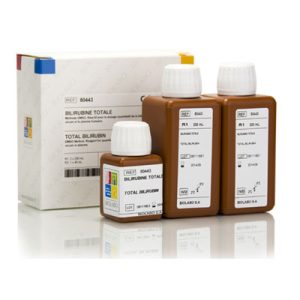No products in the cart.
HDL – Cholesterol Biochemistry Reagent – Labkit
2,200.00৳ Original price was: 2,200.00৳ .2,000.00৳ Current price is: 2,000.00৳ .
HDL-Cholesterol Biochemistry Reagent – Labkit
- Brand : Labkit
- Origin : Spain
- Packing Size: 3x10 ml
- Number of Test: 30Test
- Method: Direct clearance method

01405100400
Free Delivery
For order. over 15,000 Taka
7 Days Return
If products have problems
Secure Payment
100% secure online payment.
Dedicated Support
Dedicated online and offline support
HDL-Cholesterol Biochemistry Reagent – Labkit
High-density lipoproteins (HDL) are the smallest of the lipoproteins, yet the most complex class of lipoproteins. HDL is comprised of several subclasses that are different in size, protein and lipid composition, physiological functions, and pathophysiological significance. Functionally, HDL mediate the transport of cholesterol from non-hepatic tissues to the liver for excretion from the body, known as reverse cholesterol transport (RCT).There is a well-established inverse correlation between plasma levels of HDL-associated cholesterol (HDL-C) and the incidence of cardiovascular disease. Attempts at therapeutic interventions to raise plasma HDL-C levels have been successful, raising it by 30% to more than 100%. However, so far the pharmacological raising of HDL-C has provided no benefit in terms of clinical outcomes.

HDL have been demonstrated to have a variety of functions, including anti-oxidative, anti-inflammatory, antithrombotic, anti-apoptotic, antidiabetic, anti-infectious, endothelial cell-repairing, and vascular endothelial function-improving effects in addition to cellular cholesterol efflux and RCT. These pleiotropic functions of HDL may be involved in the prevention of atherosclerosis progression. HDL has several potential anti-atherogenic effects and protective effects on endothelial cells. Therefore abnormal and reduced vasoprotective effects of HDL are closely associated with atherogenesis and an increased risk of cardiovascular disease. Oxidative modifications have been proposed for alteration and deterioration of HDL. The oxidation of HDL particles is likely to have important consequences not only for cholesterol homeostasis in peripheral tissues but also for the development of vascular diseases associated with oxidative stress. Accurate measurement of HDL-C is of vital importance when assessing patient’s risk for CHD.
Buy Best Biochemistry Analyzer From Medistore
Brand
Labkit
Be the first to review “HDL – Cholesterol Biochemistry Reagent – Labkit” Cancel reply
Related Products
Related products
-
Biochemistry Reagents
AMS Cholesterol 2x60ml
Rated 0 out of 53,000.00৳Original price was: 3,000.00৳ .2,400.00৳ Current price is: 2,400.00৳ . Add to cart -
Biochemistry Reagents
AMS Amylase
Rated 0 out of 53,500.00৳Original price was: 3,500.00৳ .3,000.00৳ Current price is: 3,000.00৳ . Add to cart -
Biochemistry Reagents
Ams Triglyceride
Rated 0 out of 53,500.00৳Original price was: 3,500.00৳ .3,000.00৳ Current price is: 3,000.00৳ . Add to cart -
Biochemistry Reagents
AMS AST GOT
Rated 0 out of 53,000.00৳Original price was: 3,000.00৳ .2,800.00৳ Current price is: 2,800.00৳ . Add to cart
Our Best Selling Products
-
Mesh Nebulizer
Mesh Nebulizer – Portable Ultrasonic Inhaler Mesh Nebulizer
Rated 0 out of 52,750.00৳Original price was: 2,750.00৳ .1,800.00৳ Current price is: 1,800.00৳ . Add to cart -
Mesh Nebulizer
Mesh Nebulizer JSL-W301 – Portable Ultrasonic Inhaler Mesh Nebulizer
Rated 0 out of 52,500.00৳Original price was: 2,500.00৳ .1,500.00৳ Current price is: 1,500.00৳ . Add to cart -
Biochemistry Analyzer
Mindray BA-88A Semi-Auto Chemistry Analyzer
Rated 0 out of 5180,000.00৳Original price was: 180,000.00৳ .150,000.00৳ Current price is: 150,000.00৳ . Add to cart -
CLIA System
AutoLumo A1860 – Automatic Chemiluminescence Immunoassay System
Rated 0 out of 51,800,000.00৳Original price was: 1,800,000.00৳ .1,600,000.00৳ Current price is: 1,600,000.00৳ . Add to cart -
Microscope/Binocular
Cypress CM001 Cyanscope Microscope
Rated 0 out of 5140,000.00৳Original price was: 140,000.00৳ .110,000.00৳ Current price is: 110,000.00৳ . Add to cart -
Ultrasound Machine
Mindray DC-N3 Pro Ultrasound Machine
Rated 0 out of 51,350,000.00৳Original price was: 1,350,000.00৳ .1,150,000.00৳ Current price is: 1,150,000.00৳ . Add to cart -
Serology Reagent
S.Paratyphi-BH Antigen Serology Reagent – Human Biolin
Rated 0 out of 51,000.00৳Original price was: 1,000.00৳ .800.00৳ Current price is: 800.00৳ . Add to cart -
Patient Monitor
EMS-15000A Patient Monitor – Esonic
Rated 0 out of 570,000.00৳Original price was: 70,000.00৳ .65,000.00৳ Current price is: 65,000.00৳ . Add to cart

















Reviews
There are no reviews yet.